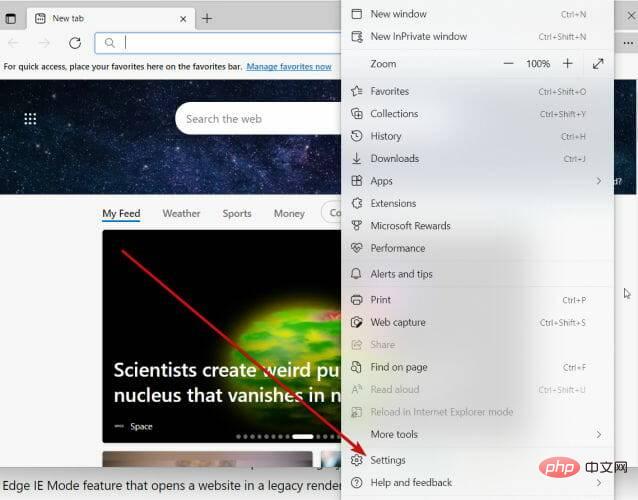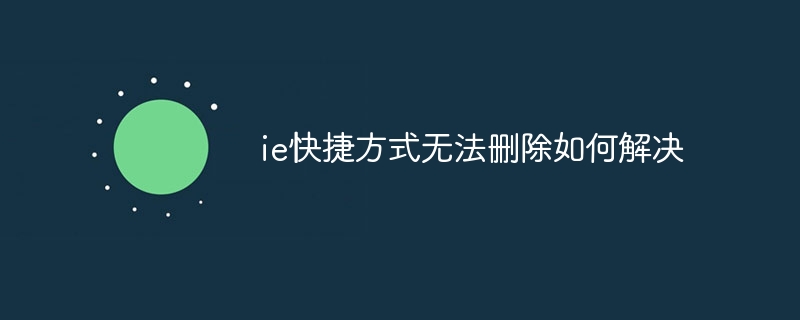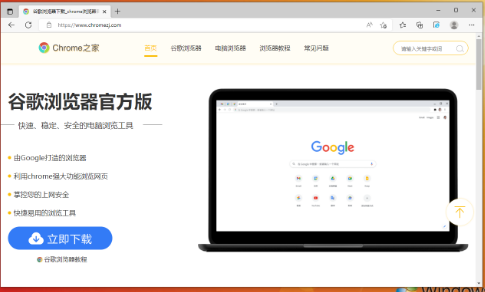 Web Front-end
Web Front-end JS Tutorial
JS Tutorial How to use vue interceptor to implement unified token and be compatible with IE9 verification
How to use vue interceptor to implement unified token and be compatible with IE9 verificationThis time I will show you how to use the vue interceptor to achieve a unified token and be compatible with IE9 verification. What are the precautions?. Here is the actual combat. Let’s take a look at the case.
In the project, vue is used to build the front-end page, and the back-end API interface is requested through axios to complete data interaction. If the verification password token is written in each interface, it will be a lot of manual work and not flexible. Here we share the use of vue's built-in interceptor to add a token to the header of each request, and it is compatible with IE9.
import axios from 'axios';
// 这里的config包含每次请求的内容,在这里把token放到请求头
axios.interceptors.request.use(function (config) {
let token = window.localStorage.getItem("tokenid"); //从缓存中取token
if (token) {
config.headers.Authorization = token; //将token放到请求头发送给服务器
//这里主要是为了兼容IE9
var browser = navigator.appName;
var b_version = navigator.appVersion;
if (browser == 'Netscape' && b_version.indexOf(';') 0) {
config.url = config.url + "&token=" + JSON.parse(token).value;
}
else {
config.url = config.url + "?token=" + JSON.parse(token).value;
}
}
}
} else {
localStorage.clear(); //清空缓存
if (router.currentRoute.name && router.currentRoute.name.toLowerCase() == "login") {
//这里需要排除登陆(或者说是第一次请求获取token)的时候的请求验证,我这里没做处理
//我的后台api接口,并没有对login接口做token验证,所以这里不做处理
} else {
//除登陆接口外,其他需要token验证的方法,会走这里且返回null
return null;
}
}
return config;
}, function (err) {
// return Promise.reject(err);
});
// http response 拦截器
axios.interceptors.response.use(
response => {
return response; //请求成功的时候返回的data
},
error => {
try {
if (error.response) {
switch (error.response.status) {
case 401://token过期,清除token并跳转到登录页面
localStorage.clear();
var baurl = window.location.href;
router.replace({
path: 'login',
query: { backUrl: baurl }
});
return;
}
}
return Promise.reject(error.response.data)
}
catch (e) {
}
});
Write it at the back. Because my token is placed in the cache, before each request, I will first take out the token on the front end and verify its timeliness. If it expires or does not exist, I will jump to the login page first without going through the interceptor. Go request request. Please also refer to the mounted() method for details.
I believe you have mastered the method after reading the case in this article. For more exciting information, please pay attention to other related articles on the php Chinese website!
Recommended reading:
How to use Vue implements drag and drop effect
The above is the detailed content of How to use vue interceptor to implement unified token and be compatible with IE9 verification. For more information, please follow other related articles on the PHP Chinese website!
 Internet Explorer 打开 Edge:如何停止 MS Edge 重定向Apr 14, 2023 pm 06:13 PM
Internet Explorer 打开 Edge:如何停止 MS Edge 重定向Apr 14, 2023 pm 06:13 PM长期以来,InternetExplorer的失宠一直不是秘密,但随着Windows11的到来,现实开始了。Edge将来不再有时取代IE,它现在是微软最新操作系统中的默认浏览器。目前,您仍然可以在Windows11中启用InternetExplorer。但是,IE11(最新版本)已经有了一个正式的退役日期,即2022年6月15日,时间在流逝。考虑到这一点,您可能已经注意到InternetExplorer有时会打开Edge,而您可能不喜欢它。那么为什么会这样呢?在
 win11无法使用ie11浏览器怎么办?(win11用不了ie浏览器)Feb 10, 2024 am 10:30 AM
win11无法使用ie11浏览器怎么办?(win11用不了ie浏览器)Feb 10, 2024 am 10:30 AM越来越多的用户开始升级win11系统,由于每个用户的使用习惯不同,还是有不少用户在使用ie11浏览器,那么win11系统用不了ie浏览器,该怎么办呢?windows11还支持ie11吗?下面就来看看解决办法。win11无法使用ie11浏览器的解决方法1、首先右键开始菜单,选择“命令提示符(管理员)”打开。2、打开之后,直接输入“Netshwinsockreset”,回车确定。3、确定之后再输入“netshadvfirewallreset&rdqu
 Win10打开IE自动跳转到Edge怎么取消_IE浏览器页面自动跳转的解决办法Mar 20, 2024 pm 09:21 PM
Win10打开IE自动跳转到Edge怎么取消_IE浏览器页面自动跳转的解决办法Mar 20, 2024 pm 09:21 PM近期不少的win10用户们在使用电脑浏览器的时候发现自己的ie浏览器总是自动的跳转到edge浏览器,那么win10打开ie自动跳转edge怎么关闭?。下面就让本站来为用户们来仔细的介绍一下win10打开ie自动跳转edge关闭方法吧。1、我们登录edge浏览器,点击右上角...,找下拉的设置选项。2、我们进入设置后,在左侧栏点击默认浏览器。3、最后我们在兼容性中,勾选不允许IE模式下重新加载网站,重启ie浏览器即可。
 一个时代的结束:Internet Explorer 11 已退役,这是你需要知道的Apr 20, 2023 pm 06:52 PM
一个时代的结束:Internet Explorer 11 已退役,这是你需要知道的Apr 20, 2023 pm 06:52 PM2022年6月15日是Microsoft结束对InternetExplorer11(IE11)的支持并关闭其旧版浏览器章节的日子。一段时间以来,该公司一直在提醒用户注意这一生命周期结束日期,并呼吁他们计划迁移到MicrosoftEdge。Microsoft将IE11与Windows8.1捆绑在一起,作为Windows的现代默认Web浏览器。尽管它从未达到Chrome的(当前)高度,但它是2014年使用量第二大的桌面浏览器,仅次于IE8。当然,随着20
 ie快捷方式无法删除如何解决Jan 29, 2024 pm 04:48 PM
ie快捷方式无法删除如何解决Jan 29, 2024 pm 04:48 PMie快捷方式无法删除的解决办法:1、权限问题;2、快捷方式损坏;3、软件冲突;4、注册表问题;5、恶意软件;6、系统问题;7、重新安装IE;8、使用第三方工具;9、检查快捷方式的目标路径;10、考虑其他因素;11、咨询专业人士。详细介绍:1、权限问题,右键点击快捷方式,选择“属性”,在“安全”选项卡中,确保有足够的权限删除该快捷方式,如果没有,可以尝试以管理员身份运行等等。
 如何启用IE的加速功能Jan 30, 2024 am 08:48 AM
如何启用IE的加速功能Jan 30, 2024 am 08:48 AMie加速功能怎么开?ie打开网页的速度太慢,我们可以在里面开启硬件加速模式。很多小伙伴反应说在使用ie浏览器的时候,打开网页的速度特别的慢,这样对我们浏览网页也造成了一定影响。就想询问小编有什么解决办法,这种情况是可以开启ie浏览器的硬件加速模式,小编下面整理了ie开启加速功能方法,感兴趣的话一起往下看看!ie开启加速功能方法打开IE安全浏览器,点击右上角齿轮状的“设置”图标,选择“Internet选项”进入,如图所示。2、在Internet选项的窗口头部的标签导航中点击“高级”,如图所示。3、
 在PHP中如何实现物联网开发?May 12, 2023 am 11:51 AM
在PHP中如何实现物联网开发?May 12, 2023 am 11:51 AM随着物联网技术的发展和普及,越来越多的应用场景需要使用PHP语言进行物联网开发。PHP作为一种广泛应用于Web开发的脚本语言,它的易学易用、开发速度快、可扩展性强等特点,使其成为开发物联网应用的一种优秀选择。本文将介绍在PHP中实现物联网开发的常用技术和方法。一、传输协议和数据格式物联网设备通常使用TCP/IP或UDP协议进行数据传输,而HTTP协议是一个优
 win10家庭版IE浏览器突然打不开了Jan 18, 2024 pm 02:57 PM
win10家庭版IE浏览器突然打不开了Jan 18, 2024 pm 02:57 PM或许有部分朋友日常工作或因个人需求而深谙于使用InternetExplorer(IE)浏览器。然而,在Windows系统版本升级至Windows10之后,他们可能会不期然遭遇IE无法正常运行之烦扰。在此种情况下,可以尝试依据Microsoft官方网站所提供的"帮助与支持中心"中的解决方案,来设法排除此问题。win10家庭版IE浏览器突然打不开了1、打开Internet选项,然后切换到连接2、再点击下面的局域网设置3、然后把这里的选项都取消勾选4、然后以管理员身份运行cmd,再输入netsh回车5


Hot AI Tools

Undresser.AI Undress
AI-powered app for creating realistic nude photos

AI Clothes Remover
Online AI tool for removing clothes from photos.

Undress AI Tool
Undress images for free

Clothoff.io
AI clothes remover

AI Hentai Generator
Generate AI Hentai for free.

Hot Article

Hot Tools

Dreamweaver Mac version
Visual web development tools

VSCode Windows 64-bit Download
A free and powerful IDE editor launched by Microsoft

MinGW - Minimalist GNU for Windows
This project is in the process of being migrated to osdn.net/projects/mingw, you can continue to follow us there. MinGW: A native Windows port of the GNU Compiler Collection (GCC), freely distributable import libraries and header files for building native Windows applications; includes extensions to the MSVC runtime to support C99 functionality. All MinGW software can run on 64-bit Windows platforms.

PhpStorm Mac version
The latest (2018.2.1) professional PHP integrated development tool

SAP NetWeaver Server Adapter for Eclipse
Integrate Eclipse with SAP NetWeaver application server.





